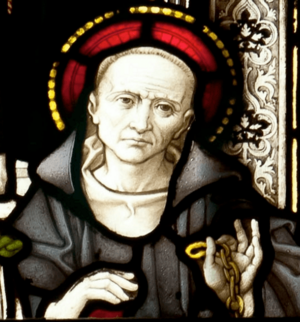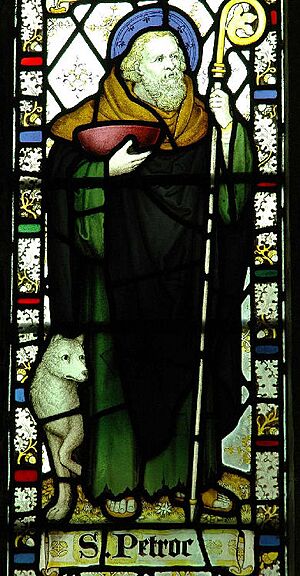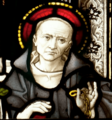Saint Petroc facts for kids
Quick facts for kids SaintPetroc |
|
|---|---|
 |
|
| Abbot of Lanwethinoc | |
| Born | c. 468 Wales |
| Died | c. 564 Treravel, Padstow, Cornwall, England |
| Venerated in | Catholic Church Anglican Communion Eastern Orthodox Church |
| Canonized | Pre-Congregation |
| Major shrine | St Petroc's Church, Bodmin, Cornwall, England |
| Feast | 4 June |
| Attributes | Wolf, stag, church |
| Patronage | Devon Cornwall |
Saint Petroc (also spelled Petrock) was an important Christian saint from Britain. He was born around the year 468 and lived until about 564. He was known as a prince from Wales who chose to live a religious life.
Petroc spent most of his life helping people in Devon and Cornwall, which were part of a kingdom called Dumnonia back then. He is especially linked to a place called Padstow in Cornwall. In fact, Padstow means "Petrock's Place," showing how important he was there.
Later, his holy items (called relics) were moved to a monastery in Bodmin. This made Bodmin a very important center for people who admired Saint Petroc. Many churches in Devon, Cornwall, and even Wales and Brittany (in France) are named after him.
Contents
The Life of Saint Petroc
The earliest stories about Petroc say he was the younger son of a Welsh leader. Some stories even say his father was King Glywys and that Petroc was the brother of another saint, Gwynllyw.
Petroc studied in Ireland and later went on a special trip, called a pilgrimage, to Rome. When he returned to Cornwall, he founded a monastery and school. This place was at the mouth of the River Camel and became known as Padstow.
He later moved from Padstow to Bodmin. There, he continued his work, helping people throughout the region of Dumnonia, which included parts of Cornwall, Devon, and other areas. He also traveled to Brittany, where he founded more churches.
One famous story says that Petroc helped convert a local ruler named Constantine of Cornwall to Christianity. This happened after Petroc saved a deer that Constantine was hunting. After many years, legend says Petroc went on another pilgrimage, traveling all the way to India! He is said to have passed away near a place called Treravel.
Why Saint Petroc is Remembered
Saint Petroc is one of the main patron saints of Cornwall, along with Saint Piran and Saint Michael. He is known for being very humble.
A popular story tells how Petroc returned from a pilgrimage. He confidently said the rain would stop, but it kept pouring for days. Feeling ashamed, he went on another pilgrimage to make up for his pride. This is when he supposedly traveled to India and even tamed a wolf! Because of this, you often see him pictured with a wolf or a stag (a type of deer).
His special day, called a feast day, is celebrated on June 4th. His main shrine, a place where people honor him, is at St Petroc's Church, Bodmin. In 1177, someone tried to steal his relics, but they were returned. Even though the relics themselves were lost later, the beautiful ivory box that held them is still on display at the church in Bodmin.
Saint Petroc's Legacy
Saint Petroc's influence can still be seen today:
- The town of Saint-Perreux in Brittany, France, is named after him.
- The Flag of Devon is dedicated to Saint Petroc. This flag was chosen in a competition in 2003 and is now used by the county.
- There are charities named after him, like St Petrock's (Exeter) Ltd and the St. Petroc's Society. These groups help people who are homeless in Devon and Cornwall.
- A college in Devon, formed by merging two other colleges, was renamed Petroc College in 2009.
Images for kids
See also
- Martyrology of Tallaght
- Category:Churches dedicated to St Petroc





